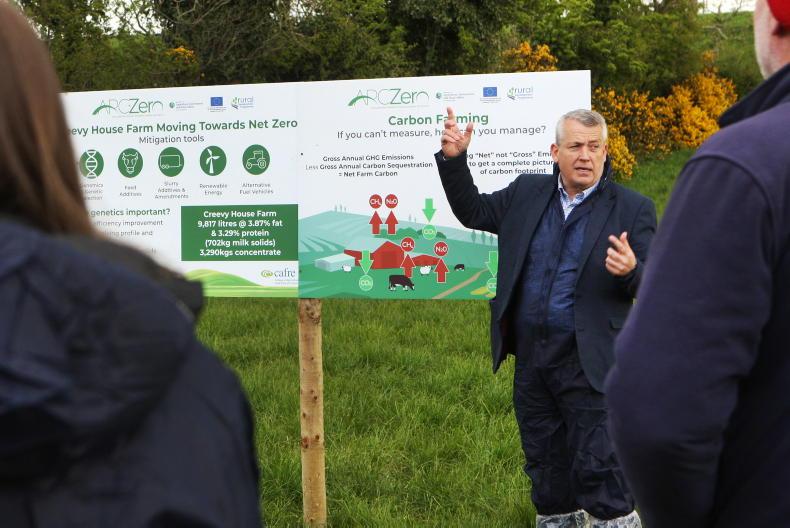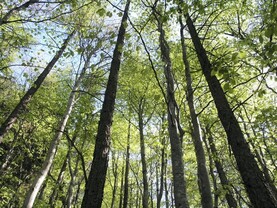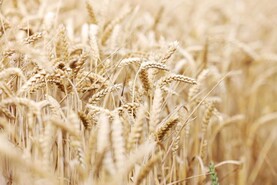The amount of carbon dioxide sequestered from the atmosphere by soils, trees and hedgerows across seven farms in Northern Ireland was measured as part of the ArcZero project.
Gross emissions are the total emissions produced within a farm and these include the likes of methane emitted by ruminant livestock and nitrous oxide from spreading fertiliser.
Net emissions are different, however, as they take into account the carbon that a farm removes from the atmosphere too.
A farm’s net emissions are calculated by subtracting the farm’s total carbon sequestration (where it takes carbon from the atmosphere and stores it in the soil, plants and trees) from its gross emissions.
Farm net emissions on the project
On the ArcZero project, each farm was carbon benchmarked, soil-sampled and mapped with LiDAR technology to assess where carbon was being emitted, sequestered and stored.
For example, a participating dairy farm had gross emissions of 2,012 tonnes (t) of carbon, but it also sequestered 550t. This equates to net emissions of 1,462t, which is 27% lower than its gross emissions.
Coincidentally, another dairy farm on the project also had a 27% difference between its gross and net emissions when carbon sequestration was measured and accounted for.
Bigger differences between gross and net emissions were seen on the other five farms, with a 31% drop observed on a beef and sheep farm.
Emissions were also reduced by 56% on a sheep farm and by 59% on an arable farm.
Beyond ‘net zero’
Quantifying carbon sequestration put two ArcZero farms beyond “net zero” emissions – meaning, the farms are already capturing more carbon than they are emitting.
However, the two farms that surpassed net zero are not like most farms in Northern Ireland, as they have small numbers of livestock and large areas with planted trees. For example, one of these farms has a fifth of its total land area in mature woodland. The other net zero farm, which belongs to Professor John Gilliland, has half the area planted in willow and another quarter is woodland.
National inventory
Speaking at an event on his farm last month, Gilliland expressed his frustration that the national system for counting emissions, known as the greenhouse gas inventory, does not attribute carbon sequestration from farms to the agriculture sector. Instead, these figures are included in the land use sector.
“If I build soil carbon, plant more hedges, is that accounted for in the inventory? Not at the moment it’s not. Policy makers have a lot of catching up to do,” he said.
Gilliland also pointed out that many carbon footprint calculators available to farmers do not account for the carbon that is removed from the atmosphere and stored in soil, trees and hedgerows.
Soils hold almost all carbon on project farms
The overwhelming majority of carbon stored on ArcZero farms was in the soil, project results have shown. Across the seven ArcZero farms, there were 515,166t of carbon stored, with 97% of it held in soils.
“If we come back and do this again in five years’ time, could we have 540,000t? Because we know our numbers, we can start to put targets around it,” Professor Gilliland said.
On the Gilliland farm, soil samples were taken to an average depth of 0.86m. Soil analysis results found that 42% of total carbon stored below permanent grassland was in the top 15cm; 23% was between 15-30cm, 22% at 30-60cm and 13% was below the 60cm mark.
There are five different types of land use on the farm. Silvopasture, where animals graze grass between trees, had the highest soil carbon stocks at over 150t/ha. This was higher than soil carbon results for both 30-year-old woodlands and 250-year-old woodlands.
Although the lowest soil carbon stock was seen in grassland, it still stood at over 120t/hectare.
However, grassland soils outperformed the other four land uses on Gilliland’s farm when it came to all measures of biological activity.
For example, grassland’s average earthworm count was almost eight times higher than silvopasture’s and 20 times higher than the willow plantation’s.
Interestingly, virtually no earthworms were found in woodland.
Soil biology
Soil respiration was measured as milligrams of carbon dioxide/kilogram of soil, with grassland scoring 135 and willow ranking second at 118. The lowest soil respiration rate was 88 for silvopasture.

Soil samples were taken to depths of up to 1m.
Another test involved measuring the decomposition of cotton pants buried in various plots around the farm.
Grassland had a decomposition rate of 29%, with willow close behind on 28%. The lowest rate of decomposition was in the 30-year-old woodland, with a score of 10%.
Striving for better carbon sequestration figures
ArcZero’s key aim was to quantify how much carbon is stored in different places on individual project farms, rather than relying on crude figures based on national – or even international – averages.
Professor John Gilliland said carbon sequestration on farms was “the poor brethren for knowledge”.
He said: “We wanted to start the journey of creating baselines for our carbon stocks under the soil and in our trees and hedges. We wanted to do this in forensic detail.”
Without question, new technologies made this project feasible at scale, such as the aerial LiDAR technology, which uses lasers to produce high-resolution, three-dimensional maps of landscapes.
Other types of equipment used included a soil sampling machine from Dundee-based firm Agricarbon, which allowed soil cores of up to one metre in depth to be collected and analysed.
The amount of carbon dioxide sequestered from the atmosphere by soils, trees and hedgerows across seven farms in Northern Ireland was measured as part of the ArcZero project.
Gross emissions are the total emissions produced within a farm and these include the likes of methane emitted by ruminant livestock and nitrous oxide from spreading fertiliser.
Net emissions are different, however, as they take into account the carbon that a farm removes from the atmosphere too.
A farm’s net emissions are calculated by subtracting the farm’s total carbon sequestration (where it takes carbon from the atmosphere and stores it in the soil, plants and trees) from its gross emissions.
Farm net emissions on the project
On the ArcZero project, each farm was carbon benchmarked, soil-sampled and mapped with LiDAR technology to assess where carbon was being emitted, sequestered and stored.
For example, a participating dairy farm had gross emissions of 2,012 tonnes (t) of carbon, but it also sequestered 550t. This equates to net emissions of 1,462t, which is 27% lower than its gross emissions.
Coincidentally, another dairy farm on the project also had a 27% difference between its gross and net emissions when carbon sequestration was measured and accounted for.
Bigger differences between gross and net emissions were seen on the other five farms, with a 31% drop observed on a beef and sheep farm.
Emissions were also reduced by 56% on a sheep farm and by 59% on an arable farm.
Beyond ‘net zero’
Quantifying carbon sequestration put two ArcZero farms beyond “net zero” emissions – meaning, the farms are already capturing more carbon than they are emitting.
However, the two farms that surpassed net zero are not like most farms in Northern Ireland, as they have small numbers of livestock and large areas with planted trees. For example, one of these farms has a fifth of its total land area in mature woodland. The other net zero farm, which belongs to Professor John Gilliland, has half the area planted in willow and another quarter is woodland.
National inventory
Speaking at an event on his farm last month, Gilliland expressed his frustration that the national system for counting emissions, known as the greenhouse gas inventory, does not attribute carbon sequestration from farms to the agriculture sector. Instead, these figures are included in the land use sector.
“If I build soil carbon, plant more hedges, is that accounted for in the inventory? Not at the moment it’s not. Policy makers have a lot of catching up to do,” he said.
Gilliland also pointed out that many carbon footprint calculators available to farmers do not account for the carbon that is removed from the atmosphere and stored in soil, trees and hedgerows.
Soils hold almost all carbon on project farms
The overwhelming majority of carbon stored on ArcZero farms was in the soil, project results have shown. Across the seven ArcZero farms, there were 515,166t of carbon stored, with 97% of it held in soils.
“If we come back and do this again in five years’ time, could we have 540,000t? Because we know our numbers, we can start to put targets around it,” Professor Gilliland said.
On the Gilliland farm, soil samples were taken to an average depth of 0.86m. Soil analysis results found that 42% of total carbon stored below permanent grassland was in the top 15cm; 23% was between 15-30cm, 22% at 30-60cm and 13% was below the 60cm mark.
There are five different types of land use on the farm. Silvopasture, where animals graze grass between trees, had the highest soil carbon stocks at over 150t/ha. This was higher than soil carbon results for both 30-year-old woodlands and 250-year-old woodlands.
Although the lowest soil carbon stock was seen in grassland, it still stood at over 120t/hectare.
However, grassland soils outperformed the other four land uses on Gilliland’s farm when it came to all measures of biological activity.
For example, grassland’s average earthworm count was almost eight times higher than silvopasture’s and 20 times higher than the willow plantation’s.
Interestingly, virtually no earthworms were found in woodland.
Soil biology
Soil respiration was measured as milligrams of carbon dioxide/kilogram of soil, with grassland scoring 135 and willow ranking second at 118. The lowest soil respiration rate was 88 for silvopasture.

Soil samples were taken to depths of up to 1m.
Another test involved measuring the decomposition of cotton pants buried in various plots around the farm.
Grassland had a decomposition rate of 29%, with willow close behind on 28%. The lowest rate of decomposition was in the 30-year-old woodland, with a score of 10%.
Striving for better carbon sequestration figures
ArcZero’s key aim was to quantify how much carbon is stored in different places on individual project farms, rather than relying on crude figures based on national – or even international – averages.
Professor John Gilliland said carbon sequestration on farms was “the poor brethren for knowledge”.
He said: “We wanted to start the journey of creating baselines for our carbon stocks under the soil and in our trees and hedges. We wanted to do this in forensic detail.”
Without question, new technologies made this project feasible at scale, such as the aerial LiDAR technology, which uses lasers to produce high-resolution, three-dimensional maps of landscapes.
Other types of equipment used included a soil sampling machine from Dundee-based firm Agricarbon, which allowed soil cores of up to one metre in depth to be collected and analysed.







 This is a subscriber-only article
This is a subscriber-only article










SHARING OPTIONS: